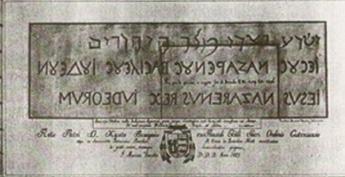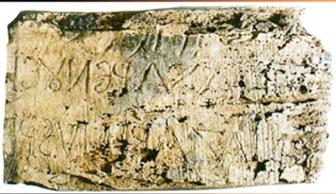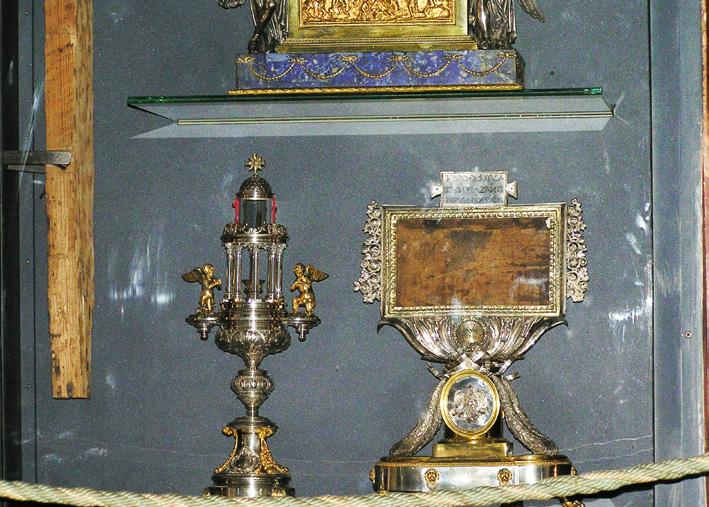
7 minute read
4 9
from Oremus May 2021
Titulus Crucis – The Title of the Cross
Louise Cowley
St Helena holds the Cross high on the roof of Santa Croce in Gerusalemme, Rome
The Title of the Cross – known in Latin as the Titulus Crucis – is the marker that identifed the chief accusation against Jesus according to the Jews: that he called himself ‘the King of the Jews’. This was considered a blasphemous claim and the Pharisees sought condemnation for it from the Romans, as it was against Jewish laws to impose the death penalty. However, even though Pontius Pilate gave in to their demands through fear of revolt, he still seemed to sense the nobility of Jesus and honoured him by the words he chose for the Title. This, of course, angered the Pharisees, which is perhaps also why he wrote what he did. As Jesus died on the Cross and bore all humiliations from men, the Titulus, instead of signalling his crime, became a sign of his glory and true identity. He was not just King of the Jews, but King of all Kings.
The earliest writer to make reference to the Title Board was St John Chrysostom (349 - 407 AD). He writes: ‘It was likely that it would be discovered in later times, and that the three crosses would lie together; so that the cross of Our Lord might not go unrecognized, it would, frstly, be lying in the middle, and secondly it was distinguished by its inscription – whereas the crosses of the thieves had no labels’. The pilgrim Egeria visited Jerusalem between 383-385 AD and wrote that she had seen the Titulus there. ‘A silver-gilt casket is brought in which is the holy wood of the Cross. The casket is opened and (the wood) is taken out, and both the wood of the Cross and the title are placed upon the table.’
The Titulus is believed to have been brought back from Jerusalem by St Helena, the mother of the Emperor Constantine, in the year 326 AD. It was found attached to the Cross, which was discovered thrown down a cistern close to Golgotha, it being a common Jewish practice to bury near the body of a public criminal whatever instrument had been used at the execution. It is believed that Helena divided the board into three parts, and this is why Egeria described a part of the board in Jerusalem. As with the Cross, she is said to have taken part of the Titulus back to Rome and sent one part to Constantinople, leaving the main bulk of it in Jerusalem.
The only known existing piece lies behind a glass cover in the Basilica of Santa Croce in Rome and its history throws up more questions than it answers - as is often the case with relics. The part kept in Rome shows S Nazarenus Re. ‘Nazarene’ or ‘of Nazareth’ in full and the last letter of ‘Jesus’ and the frst two letters of ‘King’ [Rex] are also seen. It is likely that the part of with the word ‘Jesus’ went to Constantinople and the part with the remainder of the letters, ‘Rex Judaeorum’, King of the Jews, stayed in Jerusalem. This last piece may have been captured during one of the city’s many takeovers throughout history. The Sack of Constantinople in 1204 is likely to have brought an end to the other part, but it is all conjecture. There remains only the mysterious piece at Rome, which refuses to be fully explained. From the evidence available, however, we can be certain from records that a Titulus existed before 1000 AD.
The Roman history
During the Middle Ages, many records of relics were destroyed, as were libraries and books through the actions of invading tribes who looted entire cities. This happened to Rome in 455 AD, when it was sacked and plundered by the Vandals. It is probable that the Titulus was frst
hidden at this time high up in the walls of the Basilica, a common practice during times of danger and unrest. Over a thousand years later, on 1 February 1492, Gonzalez de Mendoza, the Cardinal whose titular church was Santa Croce was repairing the roof of the basilica and by chance knocked his hammer into part of the wall. This split open and the pieces fell into the cavity behind, revealing a leaden box which was removed by the workmen. Its preservation at the apex of an arch was assured, being carefully hidden in a place rarely touched, save for the few occasions of repairs over many centuries.
On the reliquary box were found the words Titulus Crucis and the seal of Cardinal Gerard Caccianemici, dated 1143. This cardinal who had sealed the casket with his name later became Pope Lucius II (1144 - 45). Had he discovered it in a similar way and decided to put it back in the walls for its own safety? No one can say for sure, as there are no records for it having been found at that time. With the Pope’s death a few years later, its location and indeed existence were not known until 1492. The fnd was hailed with joy and no one doubted its authenticity. Cardinal de Mendoza ordered that the relic be shown to the people of Rome and the whole of the city went to kneel before it. It was recorded in 1492 that the red colour of the letters was still distinctly visible. It was a Roman tradition to whitewash the boards and then colour the letters red, but by 1789 the white and red colours had disappeared entirely, giving way to a ‘dull, leaden colour.’
However, even though there is much that points to the Titulus as being authentic, carbon dating tests performed by the Roma Tre University in 2002 showed the age of the wood as between 980 and 1146 AD. The results were published in the peer-reviewed journal Radiocarbon and another relic was consigned to being a medieval artefact at best. However, its history is a little more complex than that. There is no record of Cardinal Caccianemici, later Pope Lucius II, having discovered it. If the Titulus is a forgery, then the only person surely who could be responsible, is the Cardinal himself. So why would he do that and if he did, what happened to the actual Titulus? The end range of the carbon dates is 1146, just three years after the date that the soon-tobe pope buried it in the walls of the basilica of Santa Croce. This had led many people to speculate that it is not authentic.
A copy of the original?
If the Cardinal had a copy made, it would have had to have been a secret affair, with a skilled craftsman employed to copy the lettering on an ancient gnarled piece of wood. It could well be that the wood aged quickly after discovery, but then why does one side have a clean cut and the other side seems almost eaten away? If it had not changed much since its discovery in 1492, then the ageing must have happened before it was preserved in the walls of the basilica. The edges of the board would certainly have experienced some decay while buried deep in the earth for 300 years. The cut edges obviously do not show these signs of decay, only the sides, and we can presume that the other two missing parts would have shown this decay as well.
Let us imagine for a moment that the Cardinal did have the original copied and succeeded in having a good copy made. Why did he have the copy interred into the walls of the church with his seal on the box, when he did not have to do this? No one would have been any the wiser. No one knew about it, so why go to the trouble of making a forgery and hiding it. Could he have wanted the glory of being remembered at a later time? It seems a bit too farfetched. Hiding a forgery and keeping the original? Someone so corrupt would not even bother having a forgery made. If he had sold it, it would have certainly resurfaced somewhere. And what point would there be in having something so holy buried with him if he was not holy himself? In summary, there was no reason to make a forgery. It is most probable that the Titulus was buried in the walls for protection against the revolutionary mob that the pope died fghting against in 1145. So if the Titulus is not a forgery, what is the evidence in favour of its authenticity? To be continued.



The portion of the Titulus displayed inside the Basilica









